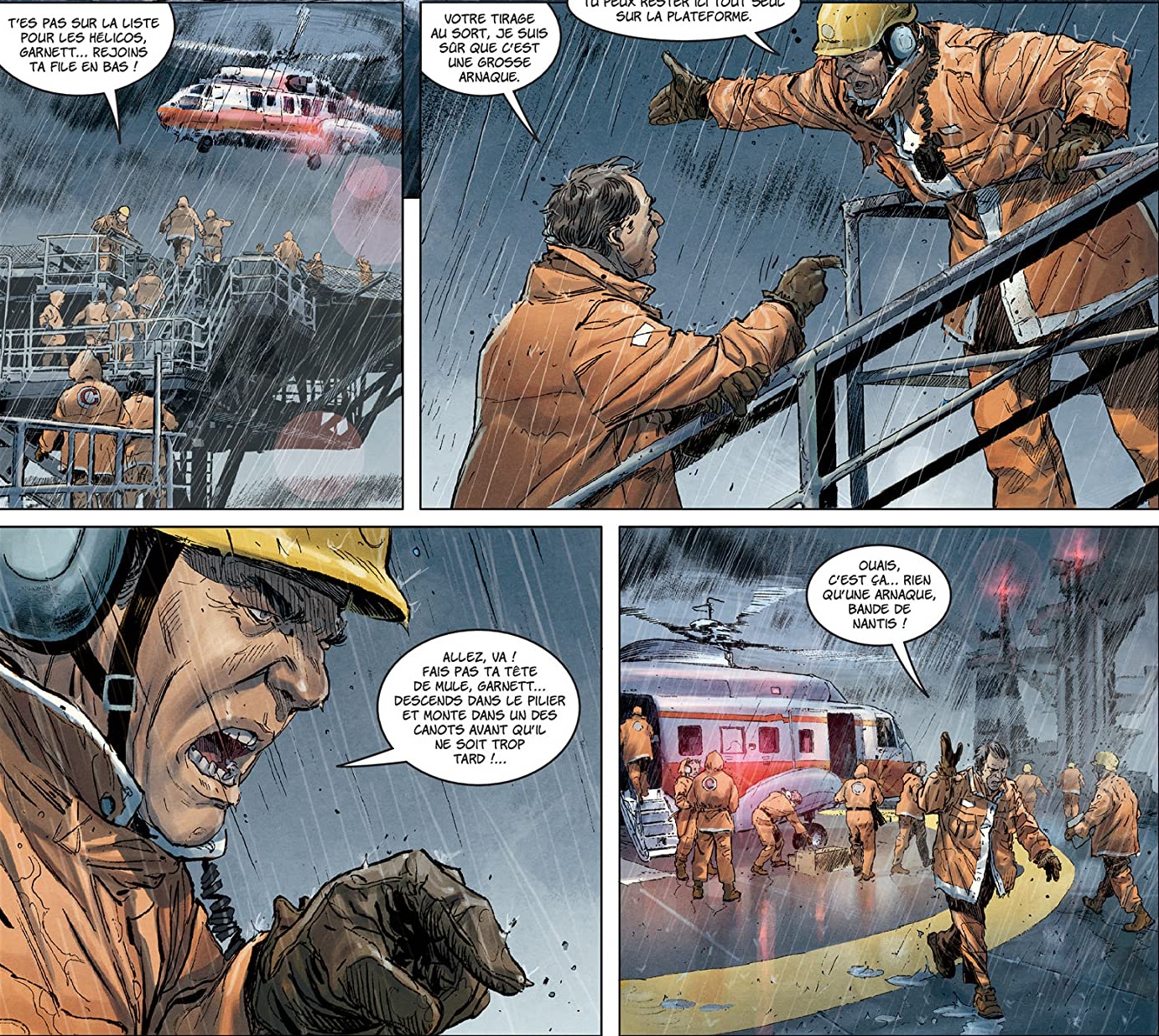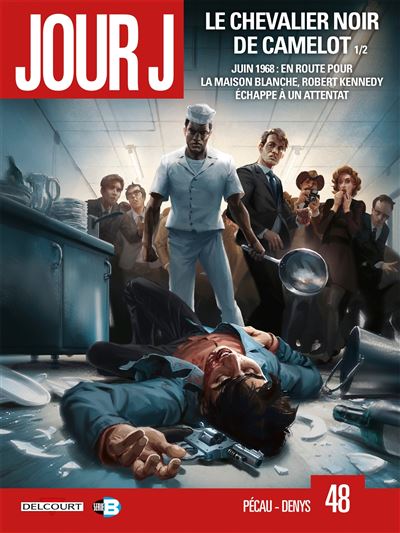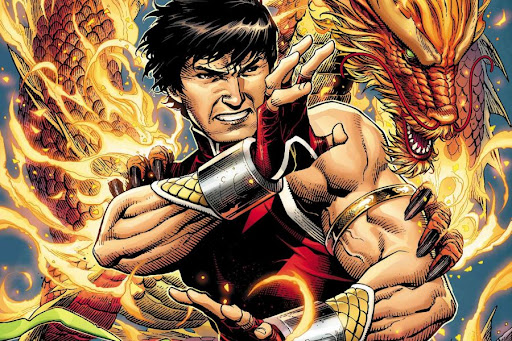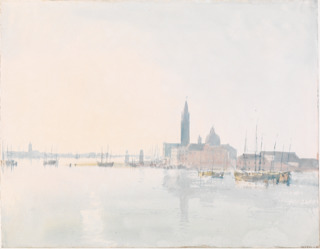Humanity, in search of new natural resources, has awakened ancient monsters in the oceans. Civilization has been totally turned upside down. Follow us into the depths of Carthago where Man becomes prey.
Nature takes revenge
 Carthago, published by Les Humanoïdes Associés, is a vast universe proposed by the screenwriter Christophe Bec. It all started during an underwater drilling. Divers are attacked by a megalodon, the prehistoric ancestor of the shark. This is only the first of the dinosaurs to appear. This return of gigantic monsters upsets humanity and the ecological balance has since been totally destroyed. In this thirteenth volume, Christophe Bec extends his ecological fable with a new cycle that takes place in the future when everything has changed on the surface of the Earth. He has already written a spin-off series with Carthago Adventures and offers here a complete story in two volumes, the Diptych of the Brawler. The first half of the book follows several protagonists. A band of looters in Scotland search for gold in a monastery, the crew of a submarine in Norway search for supplies, and a woman with gills lives in the water off the Kampchaka. Although apart, these three groups will meet again in the course of the story. In the drawings, Eric Henninot and Milan Jovanovic are replaced in this thirteenth volume of Carthago by Ennio Bufi who is up to this challenge. His realistic and precise drawing impresses during the vast underwater scenes but he also makes beautiful pages on the daily life of a monastery. Its layout is very varied. He chooses small characters because this new world is more important.
Carthago, published by Les Humanoïdes Associés, is a vast universe proposed by the screenwriter Christophe Bec. It all started during an underwater drilling. Divers are attacked by a megalodon, the prehistoric ancestor of the shark. This is only the first of the dinosaurs to appear. This return of gigantic monsters upsets humanity and the ecological balance has since been totally destroyed. In this thirteenth volume, Christophe Bec extends his ecological fable with a new cycle that takes place in the future when everything has changed on the surface of the Earth. He has already written a spin-off series with Carthago Adventures and offers here a complete story in two volumes, the Diptych of the Brawler. The first half of the book follows several protagonists. A band of looters in Scotland search for gold in a monastery, the crew of a submarine in Norway search for supplies, and a woman with gills lives in the water off the Kampchaka. Although apart, these three groups will meet again in the course of the story. In the drawings, Eric Henninot and Milan Jovanovic are replaced in this thirteenth volume of Carthago by Ennio Bufi who is up to this challenge. His realistic and precise drawing impresses during the vast underwater scenes but he also makes beautiful pages on the daily life of a monastery. Its layout is very varied. He chooses small characters because this new world is more important.
A disaster comic book in the ocean
 In 2029, the world was ravaged by nuclear explosions. On the surface, humanity is in survival mode. The platform where it all began, has become a monastery. Conversely, life remains rich in the oceans beyond 300 m depth. In the depths, an amphibious woman lives among newts that could come straight out of ancient mythology. Lou Melville manages megalodons and communicates with them through thought. Known for this talent, she is responsible for accompanying the horde in a freer space. It was during this journey that she was taken in by the religious. His stay on the platform disrupted the life of the monastery. She observes with an outside eye the tension that rises in the monastery between the emergence of a new belief and the maintenance of the Catholic faith. Even if you've never followed the Carthago series, you can start with this volume. The first pages present the world after. Even if the neophyte has gaps, these gaps will make him want to read to understand who this amphibious woman is and how these newts appeared. You can get an idea of the series by a video trailer on this link. Like disaster movies such as Godzilla or The Day After, Carthago thinks big. The book opens with the destruction of the world seen from the platform. A trade unionist complains about the unfairness of the methods of escape, but during the nuclear explosion, this will not change anything. Since then, the world has changed. The fashion is for anti-radiation suits. Justice is that of the prowlers who plunder the ruins. The state has disappeared because the submarine is fending for itself to survive. Through this post-apocalyptic world, this series spreads an ecological message. Christophe Bec even describes the harsh living conditions of megalodons in a basin. There are also very scientific passages on the sound in the water or the behavior of sharks. By Lou's surname, we also see the connection with the novel Moby Dick. Carthago crosses a new threshold in this thirteenth volume. The reader discovers the world after the disaster but above all he feels a muted threat mounted within a community stuck on a platform in the middle of the ocean. Here is the promise of a very tense second volume. We can find in Amen and The Blood of the Immortals the same theme of nature martyred by human greed.
In 2029, the world was ravaged by nuclear explosions. On the surface, humanity is in survival mode. The platform where it all began, has become a monastery. Conversely, life remains rich in the oceans beyond 300 m depth. In the depths, an amphibious woman lives among newts that could come straight out of ancient mythology. Lou Melville manages megalodons and communicates with them through thought. Known for this talent, she is responsible for accompanying the horde in a freer space. It was during this journey that she was taken in by the religious. His stay on the platform disrupted the life of the monastery. She observes with an outside eye the tension that rises in the monastery between the emergence of a new belief and the maintenance of the Catholic faith. Even if you've never followed the Carthago series, you can start with this volume. The first pages present the world after. Even if the neophyte has gaps, these gaps will make him want to read to understand who this amphibious woman is and how these newts appeared. You can get an idea of the series by a video trailer on this link. Like disaster movies such as Godzilla or The Day After, Carthago thinks big. The book opens with the destruction of the world seen from the platform. A trade unionist complains about the unfairness of the methods of escape, but during the nuclear explosion, this will not change anything. Since then, the world has changed. The fashion is for anti-radiation suits. Justice is that of the prowlers who plunder the ruins. The state has disappeared because the submarine is fending for itself to survive. Through this post-apocalyptic world, this series spreads an ecological message. Christophe Bec even describes the harsh living conditions of megalodons in a basin. There are also very scientific passages on the sound in the water or the behavior of sharks. By Lou's surname, we also see the connection with the novel Moby Dick. Carthago crosses a new threshold in this thirteenth volume. The reader discovers the world after the disaster but above all he feels a muted threat mounted within a community stuck on a platform in the middle of the ocean. Here is the promise of a very tense second volume. We can find in Amen and The Blood of the Immortals the same theme of nature martyred by human greed.









































